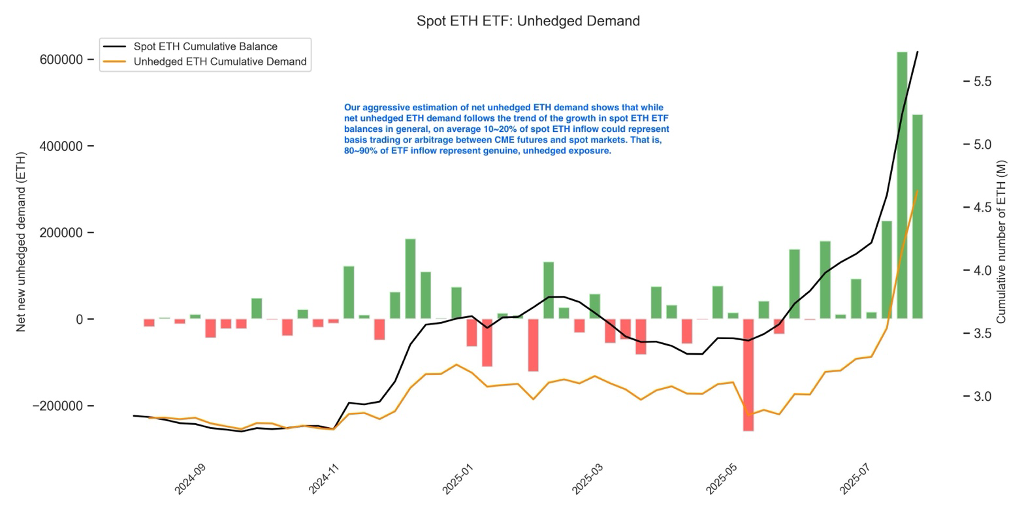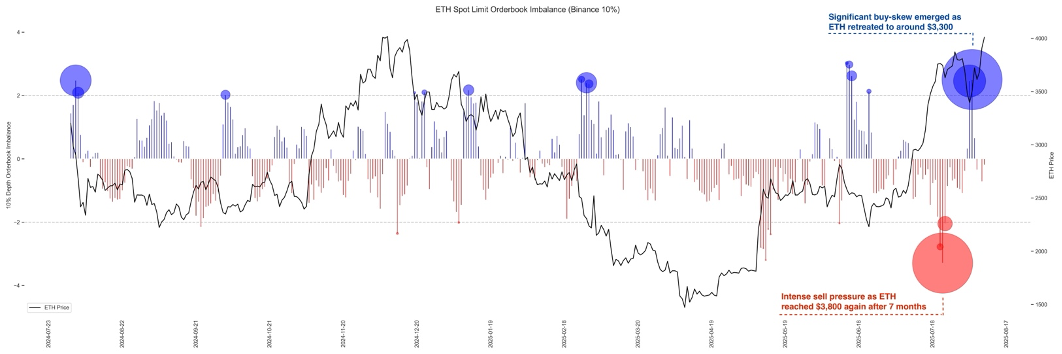CoinDesk Indices, Institutional Adoption, indicators, Liquidity, CoinDesk Indices, Crypto Long & Short, Opinion, Opinion Kelly Ye and Helena Lam of Avenir Group explore how liquidity indicators could reveal underlying capital flows and liquidity conditions for ether, and how there may still be ample room for expansion as institutional interest accelerates.
In our previous research report titled Bitcoin’s Liquidity Trifecta: Unpacking Liquidity Across On-Chain Data, Market Microstructure and Macro Drivers, we explored how various liquidity indicators could reveal underlying capital flows and liquidity conditions for bitcoin. Applying that same framework to ether (ETH) gives us valuable insight into its current liquidity profile — both on-chain and in the broader market. In this update, we also highlight the growing role of digital asset treasuries (DATs) which have emerged as a key driver behind ETH’s recent rally.
Webinar alert: On September 9 at 11:00am ET join Michelle Noyes from AIMA and Andy Baehr from CoinDesk Indices as they discuss building a sustainable business in the cyclical markets of crypto. Register today. https://aima-org.zoom.us/webinar/register/4917558078322/WN_3jAGIrqMTK2z7e74q5bkWg#/registration
Event alert: CoinDesk: Policy & Regulation in Washington D.C. on September 10th. The agenda includes senior officials from the SEC, Treasury, House, Senate and OCC, plus private roundtables and unparalleled networking opportunities. Use code COINDESK15 to save 15% on your registration. http://go.coindesk.com/4oV08AA.
1. Realized cap: measuring new capital inflows
Realized cap tracks the net USD-denominated capital invested in a token, reflecting the cumulative cost basis of all holders. Since the cycle low in November 2022, ETH has absorbed over $81 billion in fresh capital inflows, pushing its realized cap to a new all-time high of $266 billion as of August 8th, 2025.
For context, this represents a 43% increase for ETH over the period — substantial, but still well below bitcoin’s 136% rise in realized cap. The slower growth rate suggests that while ETH has been attracting meaningful new investment, there may still be ample room for expansion as institutional interest accelerates.
2. Unhedged spot ETH ETF demand: tracking institutional allocation
In our bitcoin study, we developed a method to estimate genuine institutional demand by isolating ETF inflows not tied to hedged arbitrage trades. Applying this framework to ETH shows that 80–90% of spot ETH ETF inflows are likely genuine institutional allocations, with the remainder driven by arbitrage strategies — long spot positions hedged via CME futures to capture price differentials.
Interestingly, the proportion of arbitrage-related flows is much higher for ETH than bitcoin, where only around 3% of spot ether ETF inflows are estimated to be arbitrage-based. This highlights that institutional allocation to ETH still lags behind BTC, though we expect this gap to close gradually with the recent influx of institutional interest in the cryptocurrency.

Data source: Avenir, CFTC, Glassnode
3. Futures and options open interest: gauging derivatives growth
As of July 21st, combined open interest (OI) in ETH futures and options stood at $71 billion. However, unlike bitcoin — where OI in perpetual futures and options is nearly balanced — ETH options OI remains less than half of perpetual futures OI.
Given that options are more often used by professional traders and institutions, this imbalance indicates that institutional derivatives participation in ETH still has significant room to grow.
4. Limit order book imbalance: reading market sentiment
Order book analysis reveals notable sentiment shifts. When ETH regained $3,800 in July after 7 months, a strong sell-side skew emerged on the limit order books (LOB), suggesting intense, long-awaited profit-taking. But as the price retraced toward $3,300, buy-side depth increased significantly, signaling “buy-the-dip” behavior at that level. Since then, the order book has shown a more balanced supply-demand profile, suggesting no extreme positioning from the market at present.

Data source: Avenir, Binance
5. Digital asset treasuries (DATs): growing structural buyers of ETH
A new and increasingly important source of demand for ETH comes from DATs — corporations that diversify into ETH by holding it on their balance sheets. For example, Bitmine and Sharplink are two of the most notable representatives of this trend.
Since April, DATs have accumulated roughly 4.1 million ETH ($17.6 billion), representing about 3.4% of the circulating supply; Bitmine alone accounts for 1.3%. For context, U.S. spot ETH ETFs currently hold 5.4% of ETH total supply. This highlights the scale of these structural allocations from DATs.
What sets DAT flows apart is their long-duration nature. Unlike futures traders or ETF arbitrage inflows, treasury allocations are less likely to rotate capital frequently, making them a source of sticky structural demand.
Conclusion
Across on-chain and off-chain liquidity metrics, one theme is clear: ETH’s institutional participation is still in the early stages compared to bitcoin. Realized cap growth, ETF inflow composition and derivatives market structure all point to significant untapped potential.
At the same time, DAT allocations are becoming a powerful driver of sustained ETH flows, much like how corporate balance sheet strategies such as Strategy created a new structural demand channel that helped fuel bitcoin’s rally in late 2024.
If institutional adoption of ETH follows a trajectory similar to bitcoin’s, the coming months could see meaningful capital inflows, and with them, the potential for outsized performance.
CoinDesk: Bitcoin, Ethereum, Crypto News and Price Data Read More
